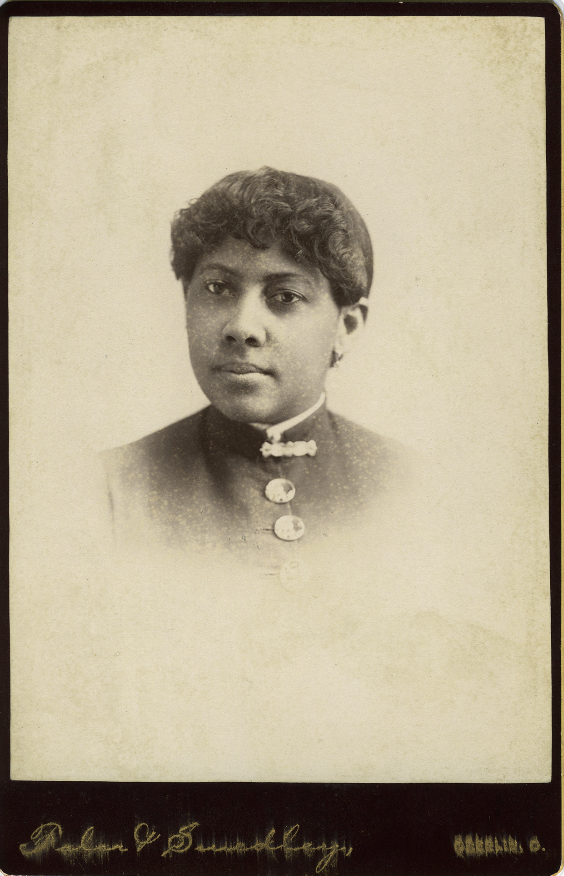History of African-American Alumnae Brought to Life
Courtesy of Oberlin College Archives
Mary Burnett Talbert, who attended Oberlin in 1886, was a civil rights and anti-lynching activist and suffragist in the early 20th century.
A new research project by the History Design Lab, an initiative of Oberlin’s History department, aims to provide histories of Oberlin-affiliated African-American women intellectuals. Former Associate Professor of History Tamika Nunley founded the Lab to engage students in archival research projects advised by faculty and professional staff. This latest project strives to increase access to an archive of often-neglected, African-American women intellectuals affiliated with the College.
Nunley taught the course Research Methods in Black Women’s Intellectual History in spring 2020, which caught the attention of the History Design Lab, a collaborative community of students, faculty, and staff aligned under the goal of a research-based history project. This spurred the lab’s African American Women Intellectuals project, dedicated to developing an archive of scholarly biographies that document African-American women who attended or were affiliated with Oberlin College.
“It becomes an ongoing space where students can do really high-level research and learn how to present that research in a way that would be on digital platforms or speak to public audiences,” said the lab’s advisor and Robert S. Danforth Professor of History Renee Romano.
After Nunley, the lab’s previous advisor and the project mentor, left for a position at Cornell University earlier this year, Romano took over in providing a space for students to learn about and research the legacies of African-American women from Oberlin.
Students work in groups with defined leaders and editors where they choose an African-American woman affiliated with Oberlin College and do extensive research on the historical figure. This includes researching within the Oberlin archives and finding letters, papers, or organizations influenced by the figure before compiling the information into an exhibit.
“A lot of the research that I did originally was in the class, and that kind of served as the model for the way that people would research going forward,” said Benjamin Clark, College third-year and Oberlin History as American History project editor in the History Design Lab.
Currently, there are 12 exhibits on the website that showcase African-American women affiliated with Oberlin College.
“We wanna focus on subjects whose stories haven’t always been told or told fully or told right,” Romano said. “You have to be really creative with how you look at sources because traditional archive collections may not be fully representing the experiences of women of color.”
The women chosen for the project, such as Ruth Anna Fisher and Shirley Graham Du Bois, excelled in many different areas. Fisher graduated from Oberlin in 1906, worked for the Carnegie Institution and later for the national archives, while Du Bois focused on producing operas that reflected the Black experience. Each exhibit showcases a different talent through the eyes of African-American women, an underrepresented group when it comes to recognition of intellectual achievements.
“A key part of this is to really recast and reframe an understanding of the important intellectual legacies and contributions,” Romano said. “They’re not just important people for what they did, but they’ve gone on to influence and shape many other aspects of things.”
For Clark, the project is exciting because it helps make valuable information more accessible to the general public.
“People can then cite those sources in a way that links back to the institution and offer those sources up to people when otherwise they would have to personally request them from the archives and do research themselves,” Clark said.
The public can also become more aware of the contributions of African-American women that have not been broadcasted throughout the United States, or even the College.
“I think a fair amount of students who go here are really interested in the history of Oberlin,” College third-year Meredith Warden said. “It has a really strong history as a radical school, but also within that, there are stories — like the story of Edmonia Lewis who was a Black woman who went here who … was the victim of racial hate crimes when she was here. I think it is really important to not just tell the stories of these women but do more research into them, so people are more aware of the fact that these women were up against so many odds.”
By contributing to this project, students have the pleasure of telling stories that hadn’t previously been told or valued, subsequently spreading the message that the story of any person’s life has inherent worth.
“If you see a wall of inventors, the chances that most of them are gonna be white men is … really high,” Romano lamented. “We need to change that, so kids recognize themselves [in their] role models.”







